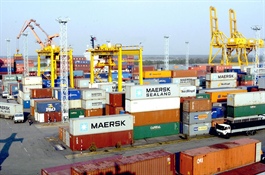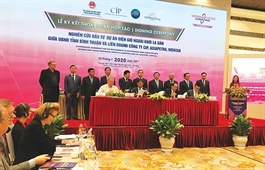Pushing up advanced solutions by bridging the digital divide
Pushing up advanced solutions by bridging the digital divide
As both Industry 4.0 and the coronavirus pandemic make their mark on the world in wildly different ways, there has become a need for government, localities, and enterprises in Vietnam to accelerate the application of digital solutions. Jeff Paine, managing director of the Asia Internet Coalition, writes about chances for enterprises to apply such solutions, and how a digital economy can help the country achieve sustainable economic growth.

Jeff Paine, managing director of the Asia Internet Coalition
|
Vietnam has received international acclaim for its quick and decisive response to the COVID-19 crisis, with the economy witnessing a 1.81 per cent GDP growth in the first half of 2020. This is encouraging as Vietnam is one of the few countries that have managed to achieve positive growth during this crisis. Vietnam’s economic outlook has therefore been hailed as one of the brightest in all of Asia.
The country has emerged as the clear early winner from the protracted and damaging US-China trade tensions, given the notable increase in trade between Vietnam and the US in the first quarter of 2020. In a push to compete for foreign direct investment, Vietnam has partnered with Indonesia and Thailand to establish cabinet-level task forces to draw investment in manufacturing supply chains, specifically from China. Also, Vietnam also saw acceleration in China’s ongoing investments in the country this year.
Moreover, digital technology continues to contribute to Vietnam’s increased revenue. In the first half of 2020, phones, electronics, and computers constituted the top commodities in Vietnam’s export value and share. The government has also announced plans to commercialise a 5G network using only domestically-produced equipment.
Notably, Vietnam has been described as the fastest-growing digital economy in Asia-Pacific. E-commerce is a key factor in this, with homegrown marketplaces like Sendo and Tiki competing with the likes of regional players such as Lazada and Shopee.
These achievements are in line with the government’s priority for the development of Industry 4.0, and will help the country strengthen its competitive advantage. The government holds ambitious goals for the digital economy to contribute 30 per cent to the country’s GDP as well as be among the top 40 countries in the Global Innovation Index rankings by 2030.
As chair of the ASEAN for 2020, Vietnam has the opportunity to accelerate and amplify its digital transformation goals across the region, with digital integration estimated to increase GDP growth in the region by up to $1 trillion by 2025. It is encouraging to note that in a recent statement, Minister of Information and Communications Nguyen Manh Hung spoke about the need for Vietnam to increase its focus on the digital economy. This speech echoes the goals of the National Strategy for the Fourth Industrial Revolution launched by the government last year. When observing this strategy and its emphasis, Vietnam’s digital push forward is evident.
However, a laser focus is needed on digital integration in order to bridge the digital divide and to further accelerate Vietnam’s economic growth and access to global opportunities.

Vietnam has been driving its digital economy and governance efforts even harder amid the coronavirus crisis, Photo: Shutterstock
|
Bridging the digital divide
Vietnam’s population of more than 96 million has significant potential which, coupled with the ASEAN bloc of 650 million people, demonstrates an equally attractive channel for Vietnamese companies. Taking advantage of these market opportunities means the Vietnamese digital economy has to be integrated into regional and global policy frameworks. Such frameworks allow cross border data flows which are the lifeblood of the digital economy, actively promoting innovation via local collaboration with global companies, and meeting global norms for protecting data privacy and security.
The digital transformation that minister Hung is seeking requires a stable regulatory and policy landscape in line with international best practices, alongside a concerted effort to bridge the digital divide. Tariff and non-tariff barriers must be reviewed, as these could hinder foreign investment and limit the prospects for local businesses.
Every country needs to invest more in providing internet access, infrastructure, and education so that all people and businesses can interact and engage seamlessly in a digital economy. According to the Organization for Economic Co-operation and Development, among the six largest economies in ASEAN, Vietnam has the third-highest high-speed internet cost at $2.41 per megabit per month. These high costs currently hamper innovation and growth in Vietnam. A digital society, such as that found today, requires the removal of regulatory and financial impediments to the construction and improvement of robust digital infrastructure. Without this infrastructure, people remain detached from the digital economy, the broader economy becomes more inefficient, and access to critical social tools, including telemedicine, distance learning, and research becomes more challenging.
Apart from resolving this digital divide and optimising infrastructure, there are several other opportunities that Vietnam can take advantage of as it charts its digital future. The first is the rapidly growing e-commerce and digital payments environment.
Vietnam’s strengths lie in its competitive telecommunications sector, a growing tech-savvy youth population, and a fledgling tech startup scene. To leverage these strengths, the country will require appropriate legislation to govern the rising volume of domestic and cross-border e-commerce transactions.
However, the same legislation should avoid being overly prescriptive, considering the power of e-commerce to create jobs and increase trade in Vietnam. In a Temasek & Bain report in conjunction with Google, Vietnam’s e-commerce market was valued at $5 billion in 2019 and is forecast to reach $23 billion by 2025 and in the past few years, emerging Vietnamese startups like Tiki have received significant investments from foreign venture capital firms and technology companies.
This buoyant outlook and investment climate opens doors for more Vietnamese entrepreneurs to develop ideas that could not only serve the Vietnamese market but also beyond. A vibrant e-commerce sector can further help Vietnam meet its free trade agreement obligations with the EU, US and the broader ASEAN region. Vietnam is also looking to harness the potential of electronic payments technology as part of the recent national financial inclusion strategy until 2025. In line with this goal, non-cash payments have increased sharply in the country, especially via mobile phones and the internet, according to the latest report from the State Bank of Vietnam.
Diverse digital economy
The second main opportunity lies in boosting technology platforms providing digital solutions such as ride-hailing and financial services, as well as grocery and parcel delivery. They form a core part of a prosperous digital economy.
The digital economy has given rise to new business models, such as the gig economy, which in turn has created more options for hundreds of thousands of micro-entrepreneurs in Vietnam to improve their livelihoods.
Tech platforms have also helped to accelerate the online presence of small and traditional businesses in Vietnam, which has helped them to continue earning revenue despite the fall in foot traffic due to COVID-19. Now, these businesses have a digital storefront to serve an increasingly online and mobile population.
The app economy is an important part of the digital economy landscape and the developer community in Vietnam has benefited significantly from the opportunities created by it. Any localisation and licensing requirements for a broad set of players will be costly – particularly to enterprises – and hinders competition and innovation. Finally, Vietnam can boost its digital strategy by a concerted focus on cloud adoption. The increased digitalisation of organisations, driven by the rapid adoption of cloud computing and data analytics, has increased the importance of data as an input to commerce, impacting not just information industries, but traditional industries as well. Cloud computing uses internet access and the ability to move data securely across borders to provide cheaper on-demand computing capacity. The benefits of clouds are best realised when there are no data localisation restrictions placed. Such restrictions undermine the economies of scale as well as the security benefits to be gained from shared computing infrastructure.
Vietnam is on a rapid journey of transformation towards a more digitalised economy. The health crisis has shown that Vietnam stands to benefit from increased digitalisation, and should drive its digital economy vision even harder. There is a universal recognition that digitalisation is a must for inclusive growth, but also makes us more resilient in times of crisis.






















